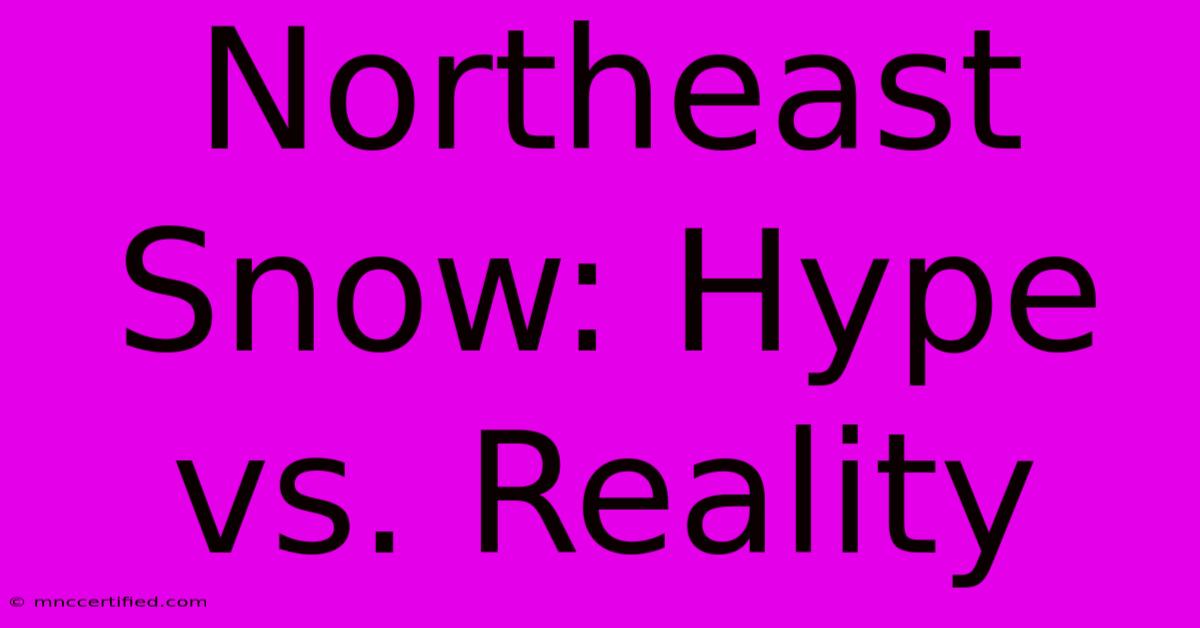Northeast Snow: Hype Vs. Reality

Table of Contents
Northeast Snow: Hype vs. Reality
The Northeast's reputation precedes it: legendary blizzards, crippling snowstorms, and winters that seem to last forever. But is the reality of Northeast snowstorms as dramatic as the hype suggests? This article dives deep into the Northeast snow experience, separating fact from fiction and helping you prepare for whatever winter throws your way.
The Hype: Northeast Snowstorms in Popular Culture
The Northeast's snowy reputation is heavily fueled by popular culture. Movies and TV shows often depict apocalyptic snowstorms, paralyzing cities and creating scenes of dramatic survival. This portrayal, while sometimes visually stunning, often exaggerates the frequency and intensity of severe winter weather. Social media, too, plays a role, with dramatic photos and videos of snow piling up quickly often going viral, further reinforcing the perception of extreme conditions. This creates a sense of dread and anticipation – often outweighing the actual, on-the-ground experience for many.
The Blizzard Myth: Not Every Storm is a Blizzard
The term "blizzard" gets thrown around liberally, often conflating strong snowfall with the true definition. A blizzard, according to the National Weather Service, requires sustained winds of 35 mph or greater, considerable falling or blowing snow that reduces visibility to less than a quarter of a mile, and these conditions lasting for at least three hours. Many significant Northeast snowstorms may be heavy, but don't meet all the criteria to be classified as a blizzard.
The Reality: Understanding Northeast Snow Patterns
While the Northeast experiences significant snowfall, the reality is more nuanced. Snowfall varies dramatically across the region, influenced by factors such as:
- Latitude: Northern areas like Vermont and Maine typically receive more snow than southern areas like New Jersey and Delaware.
- Elevation: Higher elevations accumulate significantly more snow than lower-lying coastal areas.
- Proximity to the coast: Coastal areas can experience milder temperatures and less snowfall than inland regions.
- Lake-effect snow: Areas near the Great Lakes, particularly upstate New York, can see intense localized snowfall due to the lake-effect.
Predictability and Preparation: The Key to a Smooth Winter
While predicting the exact amount of snowfall can be challenging, modern meteorology provides reasonably accurate forecasts days in advance. Knowing the projected snowfall allows for proper preparation:
- Stock up on essentials: Food, water, medications, batteries, and flashlights are crucial during power outages.
- Prepare your vehicle: Check your tire pressure, antifreeze, and windshield wipers, and keep a winter emergency kit in your car.
- Stay informed: Monitor weather forecasts closely and heed any warnings or advisories.
- Adjust your plans: If a major storm is predicted, consider rescheduling travel or working from home.
Managing Expectations: Embrace the Season, Not the Fear
The key to a positive winter experience in the Northeast lies in managing expectations. While significant snowstorms are a possibility, they are not the norm. By understanding the regional variations in snowfall, preparing adequately, and staying informed, you can navigate the winter months safely and even enjoy the beauty of a snow-covered landscape. Don't let the hype overshadow the reality – embrace the unique challenges and rewards of Northeast winters.
Off-Page SEO Considerations
To improve the ranking of this article, consider the following off-page SEO strategies:
- Guest posting: Contribute articles about winter weather preparedness or Northeast travel to relevant blogs and websites.
- Social media promotion: Share the article on platforms like Twitter, Facebook, and Instagram, using relevant hashtags like #NortheastWinter, #SnowStorm, #WinterPrep.
- Backlink building: Reach out to websites and blogs related to weather, travel, and outdoor activities in the Northeast to earn backlinks to your article.
- Community engagement: Participate in online forums and discussions related to winter weather in the Northeast, naturally linking back to your article when relevant.
By combining strong on-page SEO with a robust off-page strategy, you significantly increase the chances of this article ranking highly in search engine results pages (SERPs). Remember to consistently monitor your website's performance and adjust your strategy as needed.

Thank you for visiting our website wich cover about Northeast Snow: Hype Vs. Reality. We hope the information provided has been useful to you. Feel free to contact us if you have any questions or need further assistance. See you next time and dont miss to bookmark.
Featured Posts
-
Bayern Munich Augsburg Match Prediction And Betting Odds
Nov 23, 2024
-
Is Massage Covered By Insurance
Nov 23, 2024
-
Biggest Market Makers In Crypto
Nov 23, 2024
-
Expanded F1 Grid Closer With Gm
Nov 23, 2024
-
Trumps Attorney General Choice Bondi
Nov 23, 2024